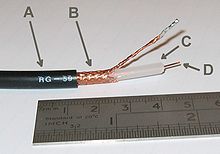
- Outer plastic sheath
- Copper braid shield
- Inner dielectric insulator
- Copper-plated core (sometimes solid core)
RG-59/U is a specific type of coaxial cable, often used for low-power video and RF signal connections. The cable has a characteristic impedance of 75 ohms, and a capacitance of around 20pF/ft (60pF/m).[1] The 75 ohm impedance matches a dipole antenna in free space. RG (for radio guide) was originally a unit indicator for bulk radio frequency (RF) cable in the U.S. military's Joint Electronics Type Designation System. The suffix /U means for general utility use. The number 59 was assigned sequentially. The RG unit indicator is no longer part of the JETDS system (MIL-STD-196E) and cable sold today under the RG-59 label does not necessarily meet military specifications.
RG-59 is often used at baseband video frequencies, such as composite video. It may also be used for broadcast frequencies, but its high-frequency losses are too high to allow its use over long distances; in these applications, RG-6 or RG-11 are used instead. In cases where the transmission distance is too long for these media, such options as UTP (unshielded twisted pair) or fiber optic can be used.
RG-59 coaxial cable is commonly packed with consumer equipment, such as VCRs or digital cable/satellite receivers. Manufacturers tend to include only RG-59 cables because it costs less than RG-6 does. However, given the short lengths provided (usually 4–6 ft or 1.2–1.8 m), this is generally sufficient for its typical use.
RG-59 is frequently used to synchronize two digital audio devices, such as ADAT optical devices. This is called word clock.
See also
[edit]- BNC connector
- Coaxial cable
- RG-58 – A similar cable but with an impedance of 50 or 52 ohms
References
[edit]- ^ "Product Specifications : 8261303/10 & 5571 WHRL RG59 40 1000" (PDF). Objects.eanixter.com. Retrieved 2016-08-03.
Well, that’s interesting to know that Psilotum nudum are known as whisk ferns. Psilotum nudum is the commoner species of the two. While the P. flaccidum is a rare species and is found in the tropical islands. Both the species are usually epiphytic in habit and grow upon tree ferns. These species may also be terrestrial and grow in humus or in the crevices of the rocks.
View the detailed Guide of Psilotum nudum: Detailed Study Of Psilotum Nudum (Whisk Fern), Classification, Anatomy, Reproduction